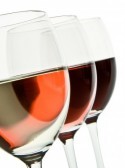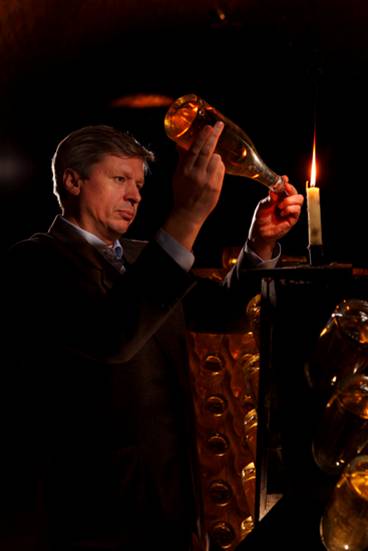Wealth Strategies
EXCLUSIVE: Biodynamics, Tradition And Craft In Quest For Fine Wine Perfection

This publication spoke to two of the most illustrious names in global fine wine production and investment to get a closer insight into the dynamics - and biodynamics - of this elite business.
In the world of fine wines and collectibles, there aren’t many
names that scale the same Everest-high peaks as Louis Roederer,
the French maker of champagne and that prince of drinks –
Cristal. It is one of those glories of craftsmanship that carries
the allure of history and is now associated with a passionate
commitment by its makers to organic best practice.
And the phenomenon of such a champagne is part of a broader story
of how buyers of fine wine - many of them now from the rising
affluent emerging market middle class - are becoming more
knowledgeable and demanding about what they buy, and are less
carried away by fads. For it is not enough these days to have a
“label” to show off to friends. What also draws people in is the
chance to learn about the painstaking skills and processes
involved in making these marvels.
There are few people on the planet with a stronger handle on what
it takes to produce fine wines than Jean-Baptiste Lécaillon, who
holds the post of chef de cave – the winemaker of the house – at
Louis Roederer, a position he has had since 1999. Working at
Louis Roederer since 1989 (it is a business where longevity
is part of the culture), Lécaillon spoke to
WealthBriefing recently about the business and how his
organisation fits into the broader fine wine story.

One of the first things that he mentioned is how small in
relative terms is the size of the French house’s estate – this is
specialist wine-making and definitely not a bulk business. The
estate is 240 hectares in size and it supplies more than 70 per
cent of Louis Roederer’s needs. “All our vintage wines at Louis
Roederer are all 100 per cent estate-grown and bottled,” he said.
The house makes more than 3 million bottles a year. The wine is
sold in around 100 nations around the world.
One notable feature of Louis Roederer’s produce is that a high
percentage – there isn’t an exact figure – is exported from
France rather than being consumed in the home market. That makes
this house an important source of overseas earnings for the
country. And that shapes how the firm works in the marketplace.
“It is not a question of market share but putting it out at the
right time and at the right price and to the right people,” he
said.
.jpg)
The ultimate Cuvée de Prestige, Cristal, was first created for
Tsar Alexander II of Russia in 1876 with a bottle design with a
flat base and made from clear crystal (hence the name), with a
distinctive orange wrapper to protect the wine from ultraviolet
light. The blend is usually 55 per cent Pinot Noir and 45 per
cent Chardonnay from only the best rated sites of Louis
Roederer’s vineyards. Cristal is released after at least six
years ageing in the Reims cellars. Among the particularly special
cuvées that the firm highlights is the “Medallion” 2002 Jeroboam
which was designed by Philippe di Méo. Each of the limited
edition release bottle sports a hand-made gold lattice “cage”,
making the 300cl jeroboam bottles even more appealing to look at.
Not only is the bottle stunning, but also 2002 was a very highly
rated vintage, renowned throughout the Champagne region of
France.
Biodynamic revolution
Lécaillon became particularly animated when he talked the
phenomenon of “biodynamics”, which is an approach to agriculture
that embraces organic techniques – and eschews man-made
chemicals. One definition describes biodynamic agriculture as “a
method of organic farming originally developed by Rudolf Steiner
that employs what proponents describe as "a holistic
understanding of agricultural processes". Soil quality, plant
growth, and livestock care are treated as being ecologically
interrelated. (It is, needless to say, not without its critics
and remains controversial in some quarters.)
“In 1999-2000 I decided to start a different form of viticulture
and came back to more ‘craftsmanship and more `haute
couture'-style of viticulture. Biodynamics is a very precise way
of looking at your vineyard. Biodynamics is about coming back to
look at the soil and using less [artificial] chemistry and
relying much more on working with the soil and the balance of the
vines,” he said. “We began with some trials…it is difficult
because in the champagne-growing region the climate can be
difficult,” Lécaillon continued.
The first trial was in 2000. Today, some 72 hectares of the
vineyard is managed via biodynamics – a substantial proportion of
the total. The commitment to the philosophy looks powerful.
Lécaillon goes into full flow: “It is about digging into your
history and know-how. Everything you do is not about how you do
it but why you do it.” And the results, he says, are glorious:
the result of using biodynamics is that the wine is richer in
taste. “Biodynamics helps you to get a more definite taste, more
precision, and done with a sense of place,” he said. As such, it
enables his business to be more distinctive and valuable in the
global marketplace.
Learning, investing with Berry Brothers &
Rudd
The approach that Louis Roederer takes is also part of a broader
trend of super high-end marques seeking to draw in clients
through education, a focus on craftsmanship and learning about
how articles are made (although of course such businesses need to
protect some secret recipes and techniques from their actual or
would-be rivals). WealthBriefing discussed this point
recently with Berry Brothers & Rudd, the specialist wine seller,
advisory and storage management firm that has been in existence
since 1698.
“We have a wine school here and have classes [to learn about
wines] almost every night,” Matthew Tipping, fine wines sales
manager at Berry Bros, told this publication from his firm’s
offices in St James’s Street. (As befitted the subject matter,
the interview happened in one of the cellar areas of the
premises; your correspondent was surrounded by dusty bottles from
Bordeaux. This counts as one of the more exotic locations for an
interview.)
As wine prices – with some fluctuations - have fetched
increasingly eye-catching prices at auction, it has also helped
galvanise an investment market in fine wines. In the early 1990s,
about 90 per cent of investment focused on the famous regions on
the right and left side of the Gironde (such as Pomerol, Médoc,
Graves and St Emilion). Since then there has been a bit more
variety in the fine wine investment market: Champagne (Cristal
and Dom Perignon, for example); the Burgundy region (output from
this area is relatively limited); the Rhone region of France,
some Australians (Penfolds) and select wines from Northern
California (such as Screaming Eagle), Tipping said.
For the moment, about 25 per cent of wine investors hold wines
purely to make money; the remainder hold it to drink it later and
if they manage to make a profit, that is a bonus, he said.
A client’s store of wines will be held in a bonded (ie,
tax-exempt) cellar and if the person wishes to sell to drink it,
he or she will pay tax on the original price paid for the wine,
not its latest value. There is now a considerable secondary
market in fine wines and clients typically use a firm such as
Berry Bros for its expertise in finding buyers, as well as for
its 300-year-plus expertise in keeping wine.
Wine investing has become less opaque in terms of price discovery
in recent years, Tipping continued. The Internet has been a boon;
there are platforms such as the Liv-ex online exchange giving out
data on what fines fetch at sale. Wine enthusiasts can still gain
pointers from such influential critics as Robert Parker; there
are also websites such as Wine-Searcher.com that provide valuable
data. Tipping also mentioned the Berrys Broking Exchange (BBX), a
technology that allows clients to use the valuation data to list
their wines at a price they choose and sell them to other
clients. “This would have been unthinkable 10 years ago,” he
said.
Berry Bros is also part of an industry network, The Bunch,
pushing for continued best practice in the sector. Tipping says
that the firm’s focus on physical ownership of wine as the best
way to invest in it stands the test of time. “We don’t think, for
example, that wine should be held in a `sub-account’ and that the
best way [to invest] is to have clear knowledge of where your
wine is and what it is worth,” he said.
Internet benefits of craftsmanship
Talk of how the Internet has taken some of the opacity from the
marketplace leads back to Louis Roederer’s Lécaillon’s comments
about how the firm’s focus on craft and biodynamics makes sense
in a more transparent world. In the internet age, when data is
easier to obtain, it is a paradox that people want more human
interaction and like to visit places where wine is produced and
see how it is made, he said.
“We have always been owned and managed by a member of the
Roederer family; today Frédéric Rouzaud – seventh generation
Roederer – is at the helm. This puts us in the fortunate position
of having records and information on the land we own stretching
back right to the foundation of the company in 1776. This gives
us a lot of information about the terroirs; how they have
performed historically, and what their characteristics are and
how that evolves,” he continued.
“You need to see that there is something behind the brand and not
just the marketing,” he said.
And this maestro of wine-making wants to leave readers with one
final, emphatic message: “Wine is good – wine is good for
health.”
